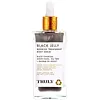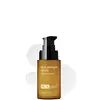What's inside
What's inside
 Key Ingredients
Key Ingredients

 Benefits
Benefits

 Concerns
Concerns

 Ingredients Side-by-side
Ingredients Side-by-side

Aloe Barbadensis Leaf Juice
Skin ConditioningWater
Skin ConditioningCaprylic/Capric Triglyceride
MaskingAdansonia Digitata Oil
EmollientCharcoal Powder
AbrasiveLeuconostoc/Radish Root Ferment Filtrate
AntimicrobialLonicera Japonica Flower Extract
Skin ConditioningLonicera Caprifolium Flower Extract
PerfumingPopulus Tremuloides Bark Extract
AntiseborrhoeicGluconolactone
Skin ConditioningTocopherol
AntioxidantPhenoxyethanol
PreservativeGlycerin
HumectantHamamelis Virginiana Water
AstringentMelaleuca Alternifolia Leaf Oil
AntioxidantAlcohol
AntimicrobialCarbomer
Emulsion StabilisingTriethanolamine
BufferingTetrasodium Glutamate Diacetate
Aloe Barbadensis Leaf Juice, Water, Caprylic/Capric Triglyceride, Adansonia Digitata Oil, Charcoal Powder, Leuconostoc/Radish Root Ferment Filtrate, Lonicera Japonica Flower Extract, Lonicera Caprifolium Flower Extract, Populus Tremuloides Bark Extract, Gluconolactone, Tocopherol, Phenoxyethanol, Glycerin, Hamamelis Virginiana Water, Melaleuca Alternifolia Leaf Oil, Alcohol, Carbomer, Triethanolamine, Tetrasodium Glutamate Diacetate
Water
Skin ConditioningHamamelis Virginiana Water
AstringentGlycerin
HumectantGlycosaminoglycans
EmollientAlcohol
AntimicrobialAlcohol Denat.
AntimicrobialGluconolactone
Skin ConditioningHydroxypropyl Cyclodextrin
MaskingAmmonium Acryloyldimethyltaurate/Vp Copolymer
Sodium Benzoate
MaskingXanthan Gum
EmulsifyingLonicera Caprifolium Flower Extract
PerfumingCocos Nucifera Fruit Juice
EmollientAdenosine
Skin ConditioningAesculus Hippocastanum Seed Extract
Skin ConditioningLavandula Hybrida Oil
EmollientLonicera Japonica Flower Extract
Skin ConditioningMelaleuca Alternifolia Leaf Oil
AntioxidantMenthyl Lactate
MaskingSantalum Austrocaledonicum Wood Oil
MaskingSilybum Marianum Extract
Skin ConditioningSodium Hyaluronate
HumectantTotarol
AntioxidantTocotrienols
Skin ConditioningElaeis Guineensis Oil
EmollientCitric Acid
BufferingPhospholipids
Skin ConditioningPotassium Sorbate
PreservativeTocopherol
AntioxidantSh-Oligopeptide-1
Skin ConditioningPalmitoyl Tripeptide-38
Skin ConditioningWater, Hamamelis Virginiana Water, Glycerin, Glycosaminoglycans, Alcohol, Alcohol Denat., Gluconolactone, Hydroxypropyl Cyclodextrin, Ammonium Acryloyldimethyltaurate/Vp Copolymer, Sodium Benzoate, Xanthan Gum, Lonicera Caprifolium Flower Extract, Cocos Nucifera Fruit Juice, Adenosine, Aesculus Hippocastanum Seed Extract, Lavandula Hybrida Oil, Lonicera Japonica Flower Extract, Melaleuca Alternifolia Leaf Oil, Menthyl Lactate, Santalum Austrocaledonicum Wood Oil, Silybum Marianum Extract, Sodium Hyaluronate, Totarol, Tocotrienols, Elaeis Guineensis Oil, Citric Acid, Phospholipids, Potassium Sorbate, Tocopherol, Sh-Oligopeptide-1, Palmitoyl Tripeptide-38
Ingredients Explained
These ingredients are found in both products.
Ingredients higher up in an ingredient list are typically present in a larger amount.
Alcohol comes in many different forms. Different types of alcohol will have different effects on skin. This ingredient is usually an astringent alcohol.
These alcohols are drying on the skin. They may strip away your skin's natural oils and even damage your skin barrier. Astringent alcohols may also irritate skin.
Other types of astringent alcohols include:
According to the National Rosacea Society based in the US, you should be mindful of products with these alcohols in the top half of ingredients.
Any type of sanitizing product will have high amounts of alcohol to help kill bacteria and viruses.
Fatty alcohols come from plant oils such as coconut oil. These can help hydrate the skin and are non-irritating. Some fatty alcohols include cetyl and stearyl alcohol.
Learn more about AlcoholGluconolactone is a PHA. PHAs are a great gentle alternative to traditional AHAs.
When applied, Gluconolactone has the same affect on skin as AHAs such as lactic acid. It helps dissolve the dead skin cells in the top layer of your skin. This improves texture and brightens the skin.
PHAs are more gentle than AHAs due to their larger structure. They do not penetrate as deeply as AHAs and take a longer time to dissolve dead cells. Studies show PHAs do not cause as much irritation.
Gluconolactone has some interesting properties:
In a 2004 study, Gluconolactone was found to prevent UV damage in mouse skin cells and has not been found to increase sun sensitivity. However, we still recommend wearing SPF daily.
This ingredient is is an created by reacting gluconic acid with an alcohol.
Learn more about GluconolactoneGlycerin is already naturally found in your skin. It helps moisturize and protect your skin.
A study from 2016 found glycerin to be more effective as a humectant than AHAs and hyaluronic acid.
As a humectant, it helps the skin stay hydrated by pulling moisture to your skin. The low molecular weight of glycerin allows it to pull moisture into the deeper layers of your skin.
Hydrated skin improves your skin barrier; Your skin barrier helps protect against irritants and bacteria.
Glycerin has also been found to have antimicrobial and antiviral properties. Due to these properties, glycerin is often used in wound and burn treatments.
In cosmetics, glycerin is usually derived from plants such as soybean or palm. However, it can also be sourced from animals, such as tallow or animal fat.
This ingredient is organic, colorless, odorless, and non-toxic.
Glycerin is the name for this ingredient in American English. British English uses Glycerol/Glycerine.
Learn more about GlycerinHamamelis Virginiana Water is made by distilling parts of the witch hazel plant. You can also call this ingredient "witch hazel water".
The name 'Hamamelis Virginiana Water' refers to the distillation product used in cosmetics. On the other hand, 'Witch Hazel' refers to the active drug ingredient.
Unless it is specified to be non-alcohol, many types of witch hazel ingredients are distilled in denatured alcohol.
Witch Hazel water is an astringent, anti-inflammatory antioxidant, and antibacterial ingredient.
It contains tannins. Tannins have a drying effect when used on skin by constricting proteins. The constriction also minimizes the appearance of pores.
Both the tannins and fragrance found in witch hazel may be skin-sensitizing.
Witch hazel water gets anti-inflammatory and antibacterial properties from its catechin and gallic acid content.
Indigenous groups have used witch hazel to help treat inflammation in North America for centuries.
Learn more about Hamamelis Virginiana WaterThis Honeysuckle flower extract comes from the Italian honeysuckle. It is an antioxidant, antimicrobial, and fragrance.
Both this and the Japanese Honeysuckle are rich in a natural paraben that give it antimicrobial property. They are effective in inhibiting bacteria, yeast, and mold.
Honeysuckle contains flavonoids and saponins. Both of these components are natural antioxidants that can help soothe the skin.
As most flowers do, honeysuckle has a natural fragrance.
Learn more about Lonicera Caprifolium Flower ExtractLonicera Japonica Flower Extract comes from the honeysuckle flower.
Honeysuckles have skin protecting, anti-viral, and anti-inflammatory properties. It contains many antioxidants, such as luteolin, caffeic acid, loniflavone, and chlorogenic acids.
This honeysuckle is native to East Asia and used in traditional Chinese medicine to treat fever and inflammation.
Learn more about Lonicera Japonica Flower ExtractThis tea tree oil comes from the leaves of the Tea Tree plant. Tea tree oil has antioxidant, anti-inflammatory, and antimicrobial properties.
According to the book Journal of Profiles of Drug Substances, tea tree helps in reducing acne-causing bacteria such as Propionibacterium acnes. This is due to the Terpinen components of tea tree oil.
Tea tree may cause sensitivity and irritation for some people. This oil naturally contains fragrance such as linalool and limonene.
However, research shows irritation usually occurs when using pure tea tree oil and not in cosmetic products.
Tea tree oil was found to help relieve the symptoms of psoriasis in one study.
Tea tree oil is toxic when ingested. Another study showed it to caused damage to the nervous system of dogs and cats when applied to their skin or given orally.
Learn more about Melaleuca Alternifolia Leaf OilTocopherol (also known as Vitamin E) is a common antioxidant used to help protect the skin from free-radicals and strengthen the skin barrier. It's also fat soluble - this means our skin is great at absorbing it.
Vitamin E also helps keep your natural skin lipids healthy. Your lipid skin barrier naturally consists of lipids, ceramides, and fatty acids. Vitamin E offers extra protection for your skin’s lipid barrier, keeping your skin healthy and nourished.
Another benefit is a bit of UV protection. Vitamin E helps reduce the damage caused by UVB rays. (It should not replace your sunscreen). Combining it with Vitamin C can decrease sunburned cells and hyperpigmentation after UV exposure.
You might have noticed Vitamin E + C often paired together. This is because it is great at stabilizing Vitamin C. Using the two together helps increase the effectiveness of both ingredients.
There are often claims that Vitamin E can reduce/prevent scarring, but these claims haven't been confirmed by scientific research.
Learn more about TocopherolWater. It's the most common cosmetic ingredient of all. You'll usually see it at the top of ingredient lists, meaning that it makes up the largest part of the product.
So why is it so popular? Water most often acts as a solvent - this means that it helps dissolve other ingredients into the formulation.
You'll also recognize water as that liquid we all need to stay alive. If you see this, drink a glass of water. Stay hydrated!
Learn more about Water